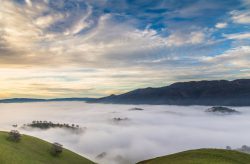
San Joaquin Valley drivers might as well call the winter “fog season” because dense ground fog fills the region’s lower areas and make it impossible for them to see.
“It’s kind of what we’re known for,” said Officer Robert Montano, community relations officer with the California Highway Patrol’s Central Division.
Named after a grass found in the Central Valley’s marshlands, Tule fog happens from surrounding moisture and dampness. The Central Valley’s mountains and the warmer air currents that floats above them holds this fog in place until the midday sun burns it away.
This weather patterns causes dozens of crashes each year – some of which are fatal – because it cuts a driver’s visibility down to an eighth of a mile on a good day and less than 10 feet in front of them on a bad one. Montano said people can reduce their chances of being in a wreck by following these tips:
- Use your low beams instead of your high beams – The bright, powerful light from a person’s high beams creates a glare when it reflects off water droplets in the air, making it even harder to see for the driver and anyone else on the road.
- Drive slowly – Colder temperatures make the fog’s water droplets sink to the ground, which can cause slick roads and even black ice. These conditions make it harder for someone to stop if they slam on the brakes.
- Open your windows – Rolling down your windows when you’re at an intersection lets you hear vehicles you might not be able to see. It also lowers the temperature inside the car, reducing the chance the moisture from your breath would condense on the windshield.
Officers with the California Highway Patrol advise drivers to pull far on to the road’s shoulder and turn off their lights if their vehicle is disabled or they no longer think its safe to drive. They should also move away from the vehicle in case it gets hit by oncoming traffic.
They also suggest postponing any travel through fog-prone areas until the morning when the sun’s warmth evaporates the moisture and causes the fog to lift. It’s better to be late or change your plans than risk wrecking your vehicle while driving through a cloud.
Sources:

